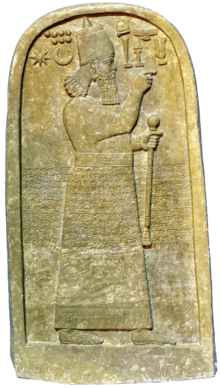Mutakkil-Nusku
Mutakkil-Nusku, inscribed mmu-ta/tak-kil-dPA.KU, "he whom Nusku endows with confidence," was king of Assyria briefly c. 1133 BC, during a period of political decline. He reigned sufficiently long to be the recipient of a letter or letters from the Babylonian king, presumed to be Ninurta-nādin-šumi, in which he was lambasted and derided.
| Mutakkil-Nusku | |
|---|---|
| King of Assyria | |
| King of the Middle Assyrian Empire | |
| Reign | 1133 BC |
| Predecessor | Ninurta-tukulti-Ashur |
| Successor | Ashur-resh-ishi I |
| Issue | Ashur-resh-ishi I |
| Father | Ashur-Dan I |
Biography
He was a younger son of the long-reigning king, Aššur-dān I (c. 1179 to 1134 BC) and succeeded his brother Ninurta-tukultī-Aššur, whom he ousted in a coup and subsequently went on to fight in a civil war that seems to have pitched the Assyrian heartland against its provinces. He appears on the Khorsabad Kinglist[i 1] which relates that “Mutakkil-Nusku, his (Ninurta-tukultī-Aššur’s) brother, fought against him. He drove him to Karduniaš (Babylonia).” Contemporary evidence suggests that Ninurta-tukultī-Aššur sought sanctuary in the border town of Sišil, where Mutakkil-Nusku’s forces engaged him in battle, the outcome of which is lost.[1]
The fragments of one or perhaps two Middle Assyrian letters exist,[i 2] from an unnamed Babylonian king, possibly Ninurta-nādin-šumi, to Mutakkil-Nusku, where he is told that "You should act according to your heart (ki libbika).” The text lambastes him for failing to keep an appointment, or a challenge, in Zaqqa and seems to confirm that Ninurta-tukultī-Aššur had reached exile in Babylonia.[2]
His victory was short-lived as ṭuppišu Mutakkil-Nusku kussâ ukta'il KUR-a e-mid, “(he) held the throne for ṭuppišu (his tablet), then died,” perhaps his inaugural year and part way into his first year only.[3] One interpretation suggests this was while his father still nominally ruled.[4] Apart from a brief economic text concerning 100 sheep of Mutakkil-Nusku, without a royal title, and his appearance in the genealogies of his descendants such as one of his sons, Aššur-rēša-iši I,[2] there are no other extant inscriptions.[4]
Inscriptions
- Khorsabad Kinglist, iii 35–36.
- Tablet fragments BM 55498 and 55499, K 212+4448 (+) Sm 2116+BM 104727.
References
- Jaume Llop, A. R. George (2001). "Die babylonisch-assyrischen Beziehungen und die innere Lage Assyriens in der Zeit der Auseinandersetzung zwischen Ninurta-tukulti-Aššur und Mutakkil-Nusku nach neuen keilschriftlichen Quellen". Archiv für Orientforschung. 48–49: 1–20.
- A. K. Grayson (1972). Assyrian Royal Inscriptions, Volume 1. Otto Harrassowitz. pp. 144–146, 149–152.
- Heather D. Baker (2010). "The meaning of ṭuppi". 104 (1). Revue d'Assyriologie: 131–162. Cite journal requires
|journal=(help) - J. A. Brinkman (1999). "Mutakkil-Nusku". In D. O. Edzard (ed.). Reallexikon Reallexikon der Assyriologie und Vorderasiatischen Archäologie: Meek – Mythologie. Walter De Gruyter. p. 500.
| Preceded by Ninurta-tukulti-Ashur |
King of Assyria 1133 BC |
Succeeded by Ashur-resh-ishi I |
